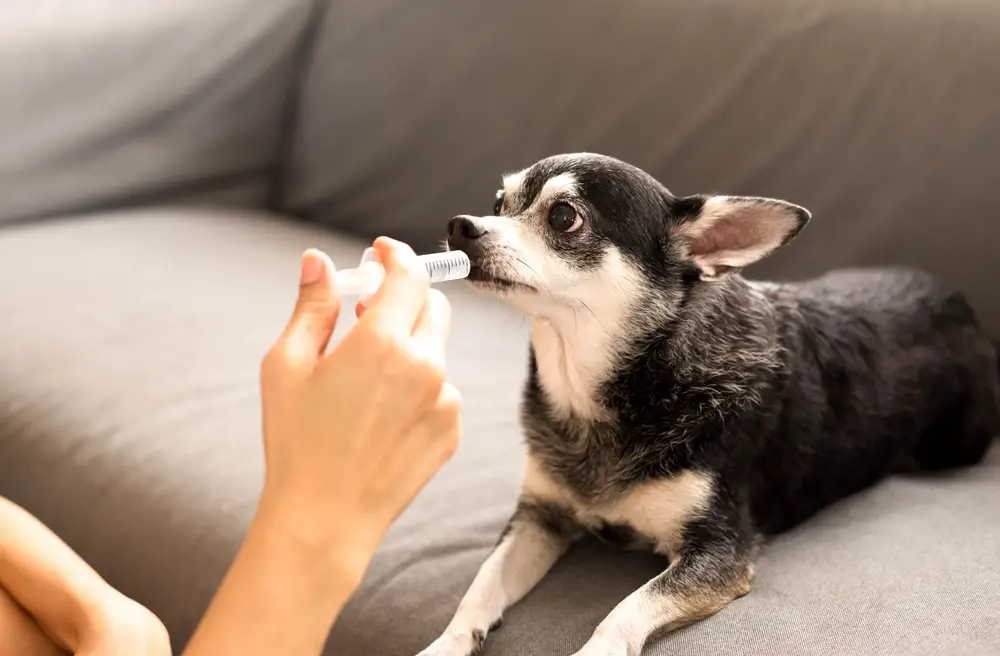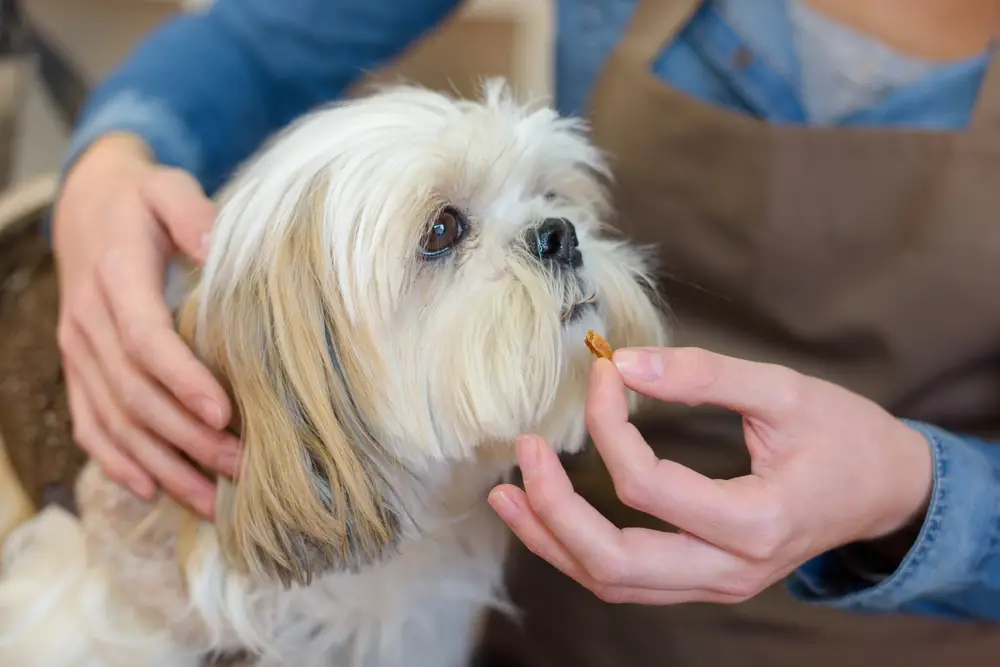Giving any medicine to your dog can be a nerve-wracking experience. You need to make sure that the medicine you choose is safe, effective, and won’t cause more harm than good.
Generally, you want to avoid giving “people medicine” to dogs. The reason for this is that dogs are more sensitive than humans when it comes to medicine. As such, using medicine incorrectly on dogs could lead to problems such as toxicity, stomach ulcers, and kidney problems.
That said, the medicine Benadryl can be safe for dogs if used properly. Here’s the rundown on giving your dog Benadryl – why you might want to and how to do so safely:
What is Benadryl?
Benadryl is an over-the-counter antihistamine. It blocks H-1 receptors found on smooth muscle and blood vessels. Those receptors can react to a wide range of allergens such as pollen, animals, dust mites, and more. Unwanted reactions include sneezing, itchiness, hives, and similar symptoms.
People use Benadryl mainly for allergy relief. It’s available in both tablet or liquid form. Benadryl is a brand name for the antihistamine diphenhydramine. You can find a variety of generic versions of diphenhydramine at most grocery and discount stores.
Diphenhydramine treats seasonal allergies, such as hay fever during the summer. It also treats specific environmental allergies such as a pet allergy. Additionally, people sometimes take Benadryl to minimize common cold symptoms.
Why Do Dogs Need Benadryl?

Just like with people, Benadryl is mainly given to dogs to treat allergy symptoms. It’s also commonly used as a:
- Mild sedative
- Motion sickness treatment
- Pre-treatment to prevent vaccine reactions
- Treatment for reactions to insect stings or bites
Here’s a closer look:
Dog Allergies
You might be surprised to learn this, but dogs suffer from many of the same types of allergies as people do. Generally, dog allergies are divided into two separate groups:
- Atopy
- Food allergies
Atopy allergies are those caused by inhaling pollens or other airborne material. It’s a lot like hay fever, only for dogs. They can be allergic to something seasonal, like pollen from a plant that blooms in the spring.
Aside from seasonal allergies, dogs can also be allergic to something in their environment. Dust mites are a common indoor allergen.
People with atopy allergies typically suffer from sneezing, congestion, red eyes, and other sinus-related issues. Dogs are different. They generally get skin problems when they have an atopy allergy.
Symptoms of Atopy Allergies
If you suspect your dog of this type of allergy watch for frequent or intense scratching. Your dog might also lick or chew his limbs, paws, or tail. Some dogs rub their heads against the furniture or floor.
Itchy skin is often the primary symptom, but secondary problems can quickly develop. Infections, especially in the ears or anal glands, are commonly caused by excessive scratching. Hair loss is also a possible complication.
Secondary symptoms are often easily treated but will keep returning until the underlying allergy problem is addressed.
Diagnosing Atopy Allergies
The cause of the allergies needs to be determined before treatment can begin. You and your vet will work together to identify what exactly your dog is allergic to.
Symptom timing can be a helpful clue. Environmental allergies are likely if your dog displays symptoms year-round. Seasonal allergies only cause symptoms during certain parts of the year.
Skin tests are the most accurate diagnostic tool. They work just like allergy tests for people. The vet will scratch small amounts of potential allergens into your dog’s skin. He or she will then closely monitor the skin’s reaction to each substance.
While accurate, skin tests can also prove unpleasant, time-consuming, and expensive. They’re usually only given to dogs with severe allergy problems.
Treating Atopy Allergies
Moderate to severe allergies typically requires a multi-faceted approach, including:
- Allergy shots to help build up a natural resistance
- Reducing exposure to the allergen as much as possible
- Symptom treatment
A skin test is needed to determine the type of allergy shot necessary.
Mild to moderate allergies respond to simpler treatments:
- Reduced exposure to the allergen (always a good idea)
- Frequent bathing
- An increase of Omega-3 fatty acids in the diet
- Antihistamines
Benadryl is most effective at treating seasonal atopy allergies of mild to moderate severity. It also treats environmental allergies. However, ultimately, you’ll be better off treating environmental allergies by changing or cleaning the environment instead of treating the symptoms with year-round use of antihistamines.
Food Allergies
About 10% of dogs have food allergies. Generally, dogs develop food allergies over time. In many cases, they’ll become allergic to the food they’d previously eaten without incident for years. Most allergies are caused by the protein in a dog’s food, although some food allergies are caused by grains.
Food allergy symptoms include skin issues such as itchiness and hair loss. However, most of the symptoms your dog suffers will likely be gastrointestinal. Watch for frequent vomiting, diarrhea, constipation, and similar issues.
Treatment for food allergies usually involves switching your dog’s dietary intake. You’ll use a process called an elimination diet. Slowly replace your dog’s existing diet with new food consisting of a different primary protein.
If symptoms subside after about a month on the new food, you’re likely dealing with an allergy. However, you’ll need to confirm the allergen by switching back to the old food. If symptoms return, you’ll switch back to the new food and this time keep your dog on the new diet.
Benadryl can sometimes help reduce symptoms of food allergies, but it doesn’t treat the underlying cause. You’ll likely notice symptom flare-ups after the antihistamine wears off. Food allergies require a diet change; Benadryl isn’t a long-term solution.
What Dosage of Benadryl is Safe for Dogs?

Always consult with your vet for specific dosing instructions.
The Merck Veterinary Manual recommends a dose between 0.9 and 1.8 milligrams of diphenhydramine for every pound of body weight. Most people round this off to 1 mg per pound of dog.
You can give diphenhydramine to a dog up to three times a day. Each dose lasts between four and six hours.
Standard tablets contain 25 mg of diphenhydramine. That’s appropriate to give to a 25-pound dog. However, it’s generally not a good idea to split tablets up for small dogs. Because dosing can be dangerously imprecise, you should only give full tablets to appropriately large dogs.
Benadryl is also available in 50 mg doses. Generally, that’s too much for most dogs, unless your dog weighs over 50 pounds. However, 80 mg is the dosage limit for all dogs, even ones that weigh more than 80 pounds.
As far as the best form of medicine to give your dog, liquid diphenhydramine is usually the best option. It’s the easiest form of Benadryl to measure with accuracy. You’ll need to be as careful with your measurements as possible, especially with small dogs. They can be sensitive to the effects of overdosage.
Liquid Benadryl can be given to the dog directly with a dropper. Simply place the dropper in his mouth and shoot the medicine down his throat. It’s not pleasant, but it also won’t hurt the dog. Some dogs tolerate taking medicine this way just fine.
Other dogs will fight you “tooth and nail” to avoid a dose of liquid medicine. For these dogs, you might find it preferable to give them tablets hidden in their food. Wet food often works best if this is the option you choose. It hides the medicine from view and masks the taste.
Benadryl should be given with a small amount of food to help prevent stomach upset.
How to Use Benadryl Safely
Check the ingredients carefully. You want pure diphenhydramine. Some brands add additional medications such as acetaminophen or pseudoephedrine. While those ingredients are perfectly fine for a person, they’re usually toxic to dogs. Also, avoid formulas with alcohol.
Many pet parents choose a children’s brand of diphenhydramine with the assumption that it’s gentler than medicine for adults. However, children’s formulas often contain artificial sweeteners or flavors, which can cause digestion problems in dogs.
You want 100% pure diphenhydramine. It’s also called “generic diphenhydramine” or “generic Benadryl.” This will contain no additional medicines or other ingredients. Most brand-name Benadryl sold in the U.S. is pure diphenhydramine, but you’ll still want to check the label to be sure.
You can find diphenhydramine marketed specifically for use by dogs. Anything called “Benadryl for dogs” is the same pure diphenhydramine used for people. Feel free to shop around for the lowest price. Don’t pay extra for pure diphenhydramine just because it’s marketed to pets. You’re probably not getting anything special.
Avoiding Potential Medical Problems
Even pure diphenhydramine can potentially cause problems. Avoid giving dogs diphenhydramine if your dog has any of the following conditions:
- Glaucoma
- High blood pressure
- Cardiovascular disease
Also, make sure the diphenhydramine won’t interfere with any other medications your dog may be taking. Contact your vet before giving your dog Benadryl for the first time.
Benadryl is generally safe to administer to dogs:
- Who currently are taking no other medications
- With no existing medical issues
- Suffering from a mild to moderate allergic reaction
Note that diphenhydramine is not an effective treatment for an acute allergic reaction. If your dog is experiencing facial swelling, difficulty breathing, or other problems that are rapidly developing, skip oral medication. Instead, take your dog to the vet for professional treatment.
When Should I Give My Dog Benadryl for Non-Allergy Related Reasons?
Benadryl helps with more than just allergies. As long as you follow the dosing guidelines and other care instructions, it’s safe to give your dog Benadryl for the following reasons:
Combating Motion Sickness
Benadryl often helps prevent vomiting, queasiness, and other issues caused by movement in a car or plane.
Mild Sedation
Many dogs feel sleepy after taking Benadryl. Because of this, it can be useful for keeping dogs calm in stressful situations such as the Fourth of July with all those distressing fireworks.
Does Benadryl Have Side Effects?
As with other medications, Benadryl can cause side effects in both people and dogs. For the most part, side effects are mild and temporary. They’re also typically similar to side effects experienced by people. Common side effects include:
Drowsiness
Benadryl makes both dogs and people tired. Don’t be surprised if your dog goes to sleep within about 45 minutes of dosing. Even if he doesn’t sleep, his energy levels will likely be low while the Benadryl is in his system.
Along with drowsiness, another related symptom is drooling. While excessive drooling can look alarming, it usually goes away after a few hours.
Excitability
Strangely enough, some dogs have the opposite reaction to Benadryl. Instead of slowing down, they speed up. Benadryl can sometimes make dogs race around, bark, and generally act excited.
As with drowsiness, this excitability is often temporary. However, you’ll want to make sure the dog doesn’t put himself at risk for any movement injuries like a twisted ankle. Also, make sure his heart rate or breathing doesn’t become too rapid.
Urinary Retention
This is one of the most common side effects. It means that your dog can’t fully empty their bladder. Urinary retention is usually caused by different obstructions, including bladder stones, blood clots, cancerous tumors, etc. The good news is that it’s a treatable condition. All you have to do is take your dog to the vet on time if you notice any signs of urinary retention.
Dry Mouth
Benadryl might affect your dog’s salivary glands, leading to dry mouth. This is commonly caused by dehydration, and it is very serious, so make sure your dog always has plenty of water available! A dry mouth may result in pain, discomfort, difficulty when eating, etc.
Hypersalivation
In addition to dry mouth, Benadryl can have the opposite effect: hypersalivation. It’s completely normal for dogs to drool frequently, but Benadryl tends to increase this by instigating excessive salivation in dogs.
Increased Heart Rate and Rapid Breathing
The normal heart rate for dogs is 70 to 120 beats per minute. Even though dogs often run around and their heartbeat gets a bit faster, the increased rate settles down within a couple of minutes. But if it doesn’t normalize as quickly as it should, and your dog starts breathing rapidly, make sure to get him checked by a vet! Heavy and rapid breathing might result from a bad reaction to the medication, and this is a serious issue that needs to be dealt with as fast as possible.
Some other side effects that are not as common include diarrhea, vomiting, and increased or decreased appetite.
You might want to avoid Benadryl if your dog shows any of the symptoms listed above, and it’d be wise to consult your veterinarian in case your dog has any of the following conditions:
- Glaucoma – pressure that causes your dog to lose eyesight
- Hypothyroidism – may lead to anemia and heart failure
- Seizure disorders such as epilepsy, kidney failure, etc.
- Hypertension – high blood pressure
- Pregnancy – this one is pretty self-explanatory!
- Cardiovascular disease – heart diseases, breathing issues, and so on
- Allergic lung disease – a parasite that causes an allergic reaction in lungs
What is a Benadryl Overdose?
Generally, Benadryl is safe when given in the correct dosage. However, accidental overdose is always a possibility.
The most common cause of an overdose is when a dog gets into a box or bottle on his own. Be sure and keep all medications stored safely in a drawer or other closed area. Dogs are especially attracted to the sweet taste of liquid Benadryl, although pills should also be kept secure.
Even administering the correct dose can potentially cause an overdose. Like people, some dogs are simply more sensitive to medications than others. Generally, you want to err on the side of lower doses when giving your dog Benadryl the first few times.
Symptoms of a Benadryl overdose can include any or all of the following:
Extreme drowsiness. General tiredness and a desire to take a nap are normal side effects. But if your dog seems too tired to function properly, he might be overdosing.
Agitation. Benadryl can make dogs feel anxious and fearful. They might pace around the house or hide under the bed. Anxious dogs are more likely to bare their teeth and act aggressively. If this occurs, speak to your dog in soft, reassuring tones and give him plenty of space.
Physical symptoms. Many overdose symptoms are easy to see. Watch for muscle tremors, breathing difficulties (either too fast or too slow), shakiness, and excessive panting. Your dog’s body temperature and blood pressure might also rise.
Dilated Pupils. Dogs’ pupils dilate due to various reasons. It may happen due to increased sensitivity to bright light, or your dog may be feeling too tense and stressed out. Pupil enlargement might also be a sign of glaucoma. Either way, if your dog has dilated pupils, it is usually not a good sign, and you should immediately get your dog checked by a vet.
Constipation. If your dog is constipated, meaning that he cannot successfully pass feces, you will notice discomfort, weird poses, a lot of walking around and scooting, and they might even cry if they’re in a lot of pain! There are numerous natural options to get your dog to do a number two, but if your dog is overdosing on medication, you should visit a vet instead of using alternative medicine on your own.
If you suspect your dog is overdosing on Benadryl, take him to the vet immediately. The earlier the treatment begins, the greater his chances of recovery.
Final Thoughts
Before giving Benadryl, check with your vet if your dog has any existing medical issues or is taking any prescription medications. Also, check with your vet before giving Benadryl to your dog for the first time.
Make sure you only use pure diphenhydramine with no alcohol, acetaminophen, or pseudoephedrine. Give your dog 1 mg of medicine per pound in weight.
Benadryl is safe and effective when properly administered to healthy dogs. Allergies are no fun – for people or pets! Fortunately, relief is available, giving you and your dog the opportunity to enjoy life and each other’s company wholeheartedly.






